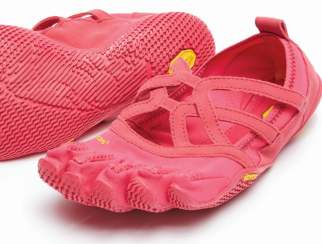This article was published in the January 2017 issue of STORES Magazine.
Vibram’s footwear may be distinct, but its counterfeit problems aren’t
A year ago, Vibram was having serious problems protecting its brand online.
Not only were fraudsters counterfeiting products and selling them online, they were also creating false profiles on social network sites; by pretending to be affiliated with the Italy-based specialty retailer and shoe manufacturer, they were luring customers to counterfeit sites.
Vibram sells rubber-soled shoes for climbing as well as a variety of unique designs that cover a range of activities from fitness training and yoga to running and sailing. The company is perhaps best known for its Vibram FiveFingers shoes.
To maintain its reputation — and retain customer loyalty — Vibram joined forces with online brand protection firm MarkMonitor. Starting with an extensive scan of over 60 marketplaces, MarkMonitor identified more than 200 websites selling counterfeit Vibram goods in just a few weeks, says Jerome Sicard, MarkMonitor’s Southern Europe regional manager.
In the next seven months, MarkMonitor removed nearly 2,000 counterfeit listings from online marketplaces; the firm also took action against counterfeit Vibram goods on 350 websites and forced third parties on 200 infringing sites to observe Vibram brand guidelines.
“Bad guys get tired of setting up shops and seeing them closed down,” Sicard says, “so progressively we are winning the battle.”
Controlling brand use
Counterfeit products distributed via online marketplaces or illegitimate websites using stolen imagery and text can look very similar to the genuine article, says Mike Wiltshire, operations manager for Primal Lifestyle, the U.K. distributor for Vibram FiveFingers.
“We want to do everything in our power to ensure that those consumers seeking genuine products are not duped by counterfeiters.”
Mike Wiltshire
Primal Lifestyle
“Many unsuspecting customers don’t realize they have been deceived until they receive poor quality product, and sometimes they receive no product at all,” he says. “We want to do everything in our power to ensure that those consumers seeking genuine products are not duped by counterfeiters. We are really impressed with the initial successes achieved by MarkMonitor.”
Wiltshire describes tackling the problem of counterfeiting and brand infringement as “an ongoing challenge,” adding that “it would be nigh impossible without the right expertise and technology in place.”
“Online fraud is affecting brands across the globe,” Sicard says. “Having a robust and effective brand protection strategy has become an inevitable requirement for all organizations conducting their business on the Internet. That includes about 90 percent of retailers.”
While online fraud threats continuously change and evolve, social media grew into a major threat last year, pitting fraudsters against e-retailers.
That means it is “very important for retailers to build and verify their presence on social networks,” Sicard says. “They need to ensure that they can control the use of their name on social networks so thieves cannot create an infringing e-commerce website and lure customers to it from fake identities they create and post on social network sites.”
There is also the strong possibility that consumers who go to a counterfeit website will become the victims of identity fraud. “The site may have a promotion that offers consumers some reward or discount if they … answer a survey and provide their personal data, creating another level of scam,” Sicard says.
“If retail loss prevention experts don’t explore what’s happening on social media sites, they are probably missing a big part of the problem.”

Strategic interactions
Working with MarkMonitor does not require any infrastructure changes or upfront investments. The service is fee-based; Sicard says the process involves a constant exchange of information conveyed through online or in-person meetings; from the retailer’s perspective, interactions include representatives from loss prevention, legal, e-commerce, customer care and operations.
“Our interactions are mostly strategic,” Sicard says. “We define the geographical priorities of the business, then we focus on protecting their assets in those specific regions.”
The Internet “changes at an incredible pace,” he says. “The digital and transactional challenges that we have now may not be the same as the challenges that face us tomorrow. When new opportunities come in terms of digital commerce, there is also a need for digital protection, and retailers should always be alert for that.”